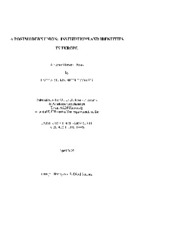| dc.creator | Cooper, Lacy Autumn Nicole | |
| dc.date.accessioned | 2013-02-22T20:39:48Z | |
| dc.date.available | 2013-02-22T20:39:48Z | |
| dc.date.created | 2002 | |
| dc.date.issued | 2013-02-22 | |
| dc.identifier.uri | https://hdl.handle.net/1969.1/ETD-TAMU-2002-Fellows-Thesis-C4643 | |
| dc.description | Due to the character of the original source materials and the nature of batch digitization, quality control issues may be present in this document. Please report any quality issues you encounter to digital@library.tamu.edu, referencing the URI of the item. | en |
| dc.description | Includes bibliographical references (leaf 31). | en |
| dc.description.abstract | The European Union has often been depicted as a postmodern political institution, primarily because it both transcends and erases the traditional boundaries of the modern nation-state. The implications of this conceptualization are far-reaching. For example, what effects might the nature of the EU have on public opinion? How might a postmodernist respond differently to the Union than a modernist? Is the familiar nationalist-Europeanist cleavage asserted by many to be the fundamental division of European identities adequate to explain support for the Union? Using Eurobarometer data I explore these questions about European identities and affect toward EU policies. It appears that two additional- postmodern- identities co-exist alongside the nationalist and the europeanist. These are the dual-identifier and the non-identifier who repeatedly display even more radical europeanist and nationalist tendencies, respectively, than their conventional counterparts. By weighting the votes of the European Council I illustrate that understanding all five European identity types is crucial for decision making in the EU as policymakers attempt to build a qualified majority coalition among the fifteen Member States. | en |
| dc.format.medium | electronic | en |
| dc.format.mimetype | application/pdf | |
| dc.language.iso | en_US | |
| dc.publisher | Texas A&M University | |
| dc.rights | This thesis was part of a retrospective digitization project authorized by the Texas A&M University Libraries in 2008. Copyright remains vested with the author(s). It is the user's responsibility to secure permission from the copyright holder(s) for re-use of the work beyond the provision of Fair Use. | en |
| dc.subject | history and political science. | en |
| dc.subject | Major history and political science. | en |
| dc.title | A postmodern Union: institutions and identities in Europe | en |
| thesis.degree.department | history and political science | en |
| thesis.degree.discipline | history and political science | en |
| thesis.degree.name | Fellows Thesis | en |
| thesis.degree.level | Undergraduate | en |
| dc.type.genre | thesis | en |
| dc.type.material | text | en |
| dc.format.digitalOrigin | reformatted digital | en |


